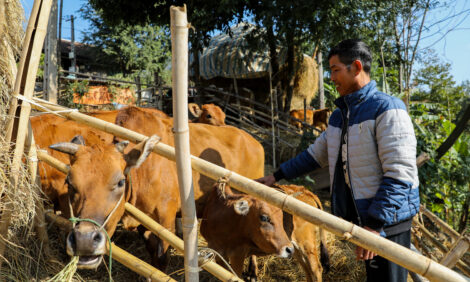



Risk assessment recommended for UK cattle as tick numbers due to peak
Tick (Ixodes ricinus) activity is expected to peak in some areas of Great Britain in the next few weeks.Ticks can transmit several infections such as bovine babesiosis (redwater), which can lead to severe, sometime fatal disease. Farmers in areas with a history of redwater may wish to take extra precautions to protect susceptible stock during this period.
Ticks are found throughout the UK but reports from cattle farmers indicate clear regional patterns. Recent research carried out by PhD student Katie Lihou and led by Professor Richard Wall at the University of Bristol, showed farmer reports of ticks on cattle are highest in north Wales, northwest England and western Scotland. Farmers in the south west of England reported the highest cases of redwater in cattle.
“Six per cent of the cattle farms surveyed reported that their cattle had ticks, but in ‘hotspot’ clusters prevalence was higher, ranging from 48 to 100%,” says Dr Rose Vineer, veterinary parasitologist at the University of Liverpool and co-author on the study.
“Two per cent of cattle farms surveyed reported tick-borne disease. However, out of these a third reported tick-borne disease in their herd.
“As expected, the study highlighted upland grazing as a significant risk factor for reporting ticks on the farm.”
Ticks were reported in all months by farmers filling out the questionnaire – with the highest proportion of reports during May to July (Figure 1).
.png)
Figure 1: Sheep and cattle farms (926 in total) reporting tick infestation in each month in a retrospective questionnaire survey in Great Britain sent out in November 2018.
Engorged ticks are easily visible on infested cattle and typically found concentrated in the skin folds between the chest and front legs and in the groin around the udder or scrotum. Ticks can vary in size depending on their stage of development and how much of a blood meal they have taken. Tick bites are often inflamed and swollen and may become infected and attract flies.
Signs of redwater fever may be the first indication of a problem, with acute disease occurring within two-weeks of an infected tick first feeding. Animals are typically severely depressed showing high fever, respiratory distress, pipestem diarrhoea, as well as the dark stained urine, which gives the condition its name. The disease is often fatal unless diagnosed and treated promptly.
Control
Tick control is difficult because ticks spend most of their life cycle away from the host, sheltered at the base of thick, damp vegetation. Attempts to reduce tick populations by environmental treatment with acaricides is unacceptable because of their effects on other invertebrates.
The Control of Worms Sustainably (COWS) group, which advises on ectoparasites as well as worms and liver fluke in cattle, suggests ‘a reduction in the tick population can be achieved through pasture improvement, drainage and scrub clearance, although this is a long-term exercise requiring sustained effort.’
Meanwhile, factors such as changing weather patterns, increased deer populations, which also act as tick hosts, and agri-environment schemes are expanding tick habitat.
A range of pour-on pyrethroids have UK licence claims for treatment of ticks on sheep, but no products in the UK have a label claim for cattle.
“Tick-borne disease of cattle can cause significant problems for farmers in ‘hot spot’ areas,” says Dr Vineer. “As with all parasites, it is worth farmers carrying out a risk assessment of their stock and the pastures to be grazed and then consider moving at-risk cattle onto safer pastures.”
“For at-risk farms, speaking to the vet is always the preferred option. They can advise on veterinary medicine options and help identify any susceptible cattle, allowing farmers to make a plan ahead of peak tick season.”
For more on tick control in cattle as well as details about lice, mite and fly control, visit the COWS website www.cattleparasites.org.uk
TheCattleSite News Desk


